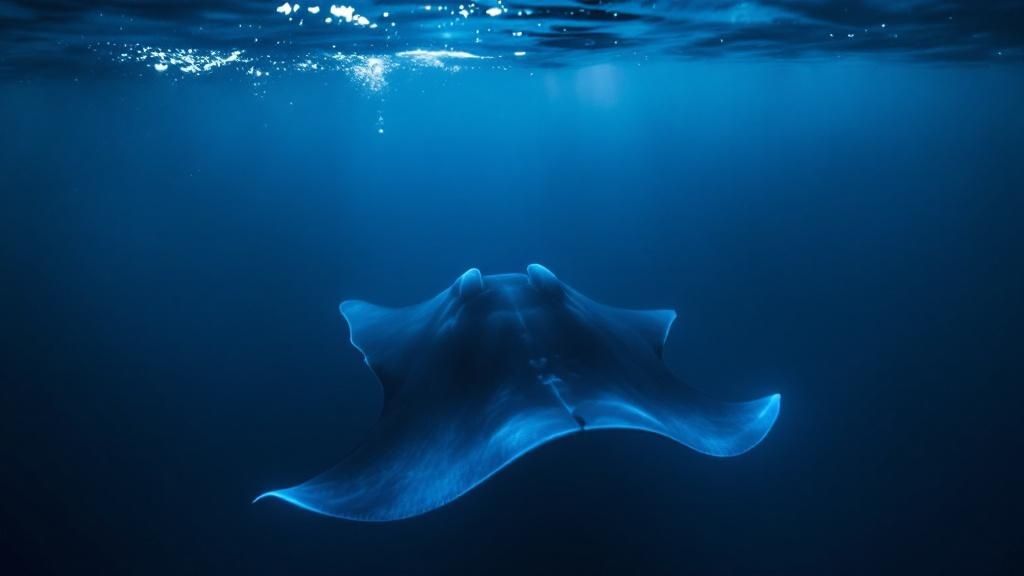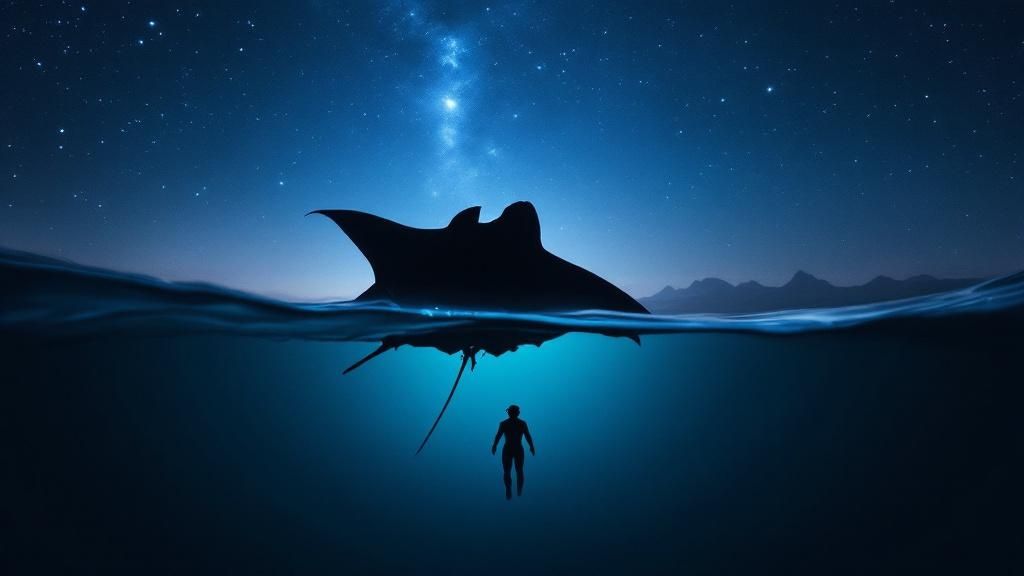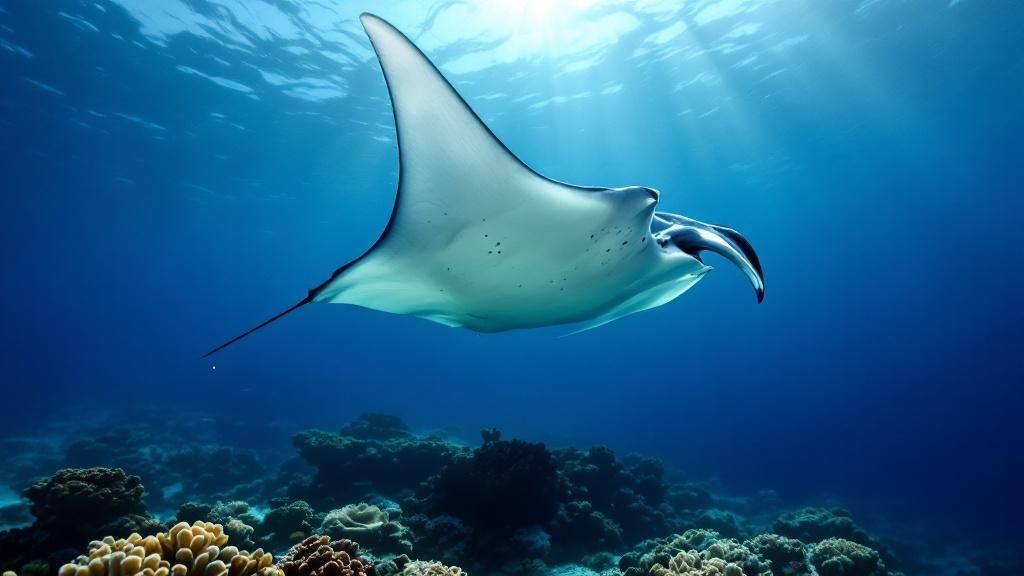Manta Ray Snorkel Kona: Your Complete Guide to Unforgettable
- Byron
- Jun 17
- 10 min read
Why Kona Became The Manta Ray Capital Of The World

Ever wonder how a single spot on the Big Island became the go-to destination for seeing manta rays? It's a fantastic story that's less about a grand design and more about a happy accident. It all started decades ago when a coastal hotel pointed bright lights onto the ocean. They weren't trying to attract marine life, but the light drew in clouds of plankton—the favorite food of our local reef mantas.
It didn't take long for the mantas to realize they'd stumbled upon a nightly, all-you-can-eat buffet. This lucky break laid the foundation for the tours we love today. Modern operators simply recreate this effect with powerful underwater lights, creating a dependable "dinner bell" for the mantas. Because Kona's manta population is non-migratory, they stick around. They know exactly where to show up for a meal, and the unique volcanic geography of the coastline helps keep the plankton concentrated in one area.
Kona’s Premier Manta Ray Hotspots
This incredible underwater ballet happens at two main locations: Manta Village (also known as Kaukalaelae Point) and Manta Heaven (Garden Eel Cove). While you can't go wrong with either, they do have some key differences. Your tour will likely go to one or the other based on conditions and where the mantas have been most active. Here’s a quick breakdown to help you understand the two primary sites.
Manta Ray Hotspots Comparison
Compare the main manta ray viewing locations in Kona including depth, accessibility, and seasonal variations
Location | Average Depth | Accessibility Level | Best Seasons | Typical Sighting Rate |
|---|---|---|---|---|
Manta Village | 25-35 ft | Easy (Shorter boat ride) | Year-round | Extremely High |
Manta Heaven | 30-40 ft | Moderate (Longer boat ride) | Year-round | Very High |
As you can see, both spots offer a fantastic and reliable experience. This consistency is exactly why the manta ray snorkel Kona adventure is world-famous. On any given night, you have an 80-90% chance of a successful sighting, which is an incredible statistic! It's no wonder this unique encounter draws around 80,000 people every year.
Knowing the history behind it all—that symbiotic relationship between human activity and marine life—makes the experience even more special. You're not just watching wildlife; you're witnessing a unique story that unfolded right here in Kona. To dive deeper into planning your trip, you can discover more about these unforgettable marine tours.
Picking The Right Tour (And Avoiding Tourist Traps)

What Defines A Quality Manta Experience?
The best operators focus on small, intimate groups. Picture this: you're floating peacefully in the dark, with plenty of personal space to watch the mantas dance below. Now, contrast that with being crammed elbow-to-elbow on a massive light raft, fighting for a view. It’s a completely different vibe.
Look for companies that are upfront about their maximum group size. A boat with 15 people offers a much more personal and serene experience than one packed with 50.
Beyond group size, a great tour is led by guides who are genuine marine advocates, not just boat drivers. They’re the ones giving you an in-depth briefing on manta biology and safety, making sure you appreciate the conservation efforts behind the experience. Their passion turns a simple activity into a truly moving and educational encounter.
Spotting Red Flags And Ensuring Reliability
A huge green flag is transparency. Reputable companies are confident in their sighting rates because they know the mantas show up consistently. In fact, local organizations have been compiling sighting statistics since 1998, creating an amazing library of data that confirms the reliability of spots like Manta Village and Manta Heaven. This historical tracking proves that a well-chosen manta ray snorkel Kona tour is almost guaranteed to be a success. You can even explore the fascinating history of Kona's manta sightings for yourself.
On the other hand, be wary of vague promises or suspiciously low prices. An unusually cheap tour often means they're cutting corners somewhere. This could mean overcrowded boats, low-quality equipment, or a rushed schedule that cuts your water time short. A quality operator invests in comfortable wetsuits, high-powered lights, and a well-maintained vessel. Their pricing reflects a real commitment to your safety, comfort, and the well-being of the magnificent manta rays.
Essential Gear That Makes Or Breaks Your Experience
Your tour company will hand you the basic gear, but don't just tune out. Getting the right fit for your equipment is the difference between a magical night and a frustrating one. Trust me, you don’t want to be fiddling with a leaky mask when a giant manta ray is gliding inches below you on your manta ray snorkel Kona trip.
Your Window to the Underwater World
Think of your mask as your personal front-row seat to the show. If it's constantly leaking or fogging up, you'll miss everything. Here's a quick pro-tip: before you even get on the boat, test the seal. Press the mask to your face—without using the strap—and breathe in gently through your nose. If it suctions to your face, you've got a winner.
Your guide will likely have some anti-fog spray, but the old-school trick of using a little spit and a quick rinse works just as well. Don't be shy; everyone does it!
Once in the water, you’ll be holding onto a specially designed flotation board. These boards have powerful lights that shine down into the depths, creating a beacon for plankton—the mantas' favorite meal. Your fins aren't for swimming after the mantas (that’s a huge no-no), but for keeping you stable and horizontal in the water, preventing your legs from sinking.
Why You'll Be Grateful for a Wetsuit
Yes, the Pacific in Hawaii is warm, but don't let that fool you. When you're floating in the dark and not moving for about 45 minutes, the chill sets in faster than you'd think. Your tour operator will provide a wetsuit, usually a 3mm "shorty" style, and you should absolutely wear it.
The wetsuit does more than just keep you warm. It also gives you extra buoyancy, which makes it much easier to float comfortably on the surface. You can just relax and let the wetsuit do the work, so all your attention is on the manta rays.
If you know you get cold easily, here's a great tip: wear a thin rash guard underneath your wetsuit. It adds an extra layer of insulation that can make a world of difference. You want to remember the mantas, not how cold you were! For more tips like this, check out our guide on the 10 essential manta ray snorkel tips.
Swimming With Giants: Techniques That Actually Work
There's a secret to making your manta ray snorkel kona adventure unforgettable, and it has nothing to do with chasing after them. The real magic happens when you become a quiet, floating part of their world. Your goal is to be a calm observer, inviting the mantas to perform their mesmerizing feeding dance all around you.
Your Front-Row Seat to the Show
Your guides will have you hold onto a large, floating light board, which is basically your personal viewing platform for the main event. The key is to think of yourself as a log on the water. Your only job is to stay horizontal and still, which presents a non-threatening shape and keeps your legs out of their feeding path.
Float flat: Keep your body parallel to the surface. Your wetsuit will help with buoyancy, and this position makes you a smaller, less intrusive object.
Still fins: Let your fins rest just below the surface without moving. Kicking or splashing can frighten the mantas and send them swimming away.
Relax your body: Hold the board securely, but don’t tense up. The more relaxed you are, the less you’ll drift or make sudden movements.
This patient approach is everything. You don’t need to do a thing, because the bright lights do all the heavy lifting by attracting the plankton that brings the mantas in for their spectacular meal.
Staying Calm When a Manta Approaches
It's one thing to talk about it, but when a manta with a 12-foot wingspan glides directly toward you, it’s natural to want to flinch. This brings us to the single most important rule of the night: do not touch the manta rays. They are covered in a protective mucous layer that our skin can easily damage, leaving them vulnerable to serious infections.
Instead of recoiling, concentrate on taking slow, steady breaths through your snorkel. This not only keeps you calm but also minimizes bubbles that might startle them. You'll witness them perform breathtaking barrel rolls, sometimes coming within inches of your mask. Trust their spatial awareness—they are expert navigators and will gracefully avoid you. The most profound moments happen when you simply float, breathe, and watch.
Adopting this respectful mindset is what turns a cool activity into an awe-inspiring encounter. To get an even better feel for the whole evening, you can Read also: The Full Manta Ray Snorkel Kona Experience.
Timing Your Visit For Maximum Magic

Aligning With Ocean Conditions
It all comes down to one thing: plankton. This is the mantas' favorite food, and your tour boat's bright lights are basically a giant dinner bell attracting it. Calmer, clearer water helps concentrate the plankton, creating a buffet that mantas can't resist. You'll often find these ideal conditions during Kona's summer months from May to September, when there's less rain and the ocean is flatter.
People often ask about the moon, but honestly, it’s not a huge factor. The boat lights are so powerful they easily outshine the moon, drawing in plankton on any night. To help you visualize how the seasons affect the experience, we've put together this handy guide.
Seasonal Manta Ray Activity Guide
Monthly breakdown of manta ray activity, weather conditions, and optimal viewing times
Month | Manta Activity Level | Weather Conditions | Water Temperature | Recommended Tour Times |
|---|---|---|---|---|
Jan-Mar | High | Can be choppy, winter swells possible | 74-76°F (23-24°C) | Sunset/Twilight |
Apr-May | High | Calming seas, transitioning to summer | 75-77°F (24-25°C) | Sunset/Twilight |
Jun-Aug | Very High | Typically calm, clear, and sunny | 78-80°F (25-27°C) | Sunset/Twilight |
Sep-Oct | Very High | Excellent; calm before winter swells | 79-81°F (26-27°C) | Sunset/Twilight |
Nov-Dec | High | Conditions can vary, potential for rain | 76-78°F (24-26°C) | Sunset/Twilight |
As you can see, while summer offers prime conditions, the mantas are active all year. The biggest variable is often the weather, not the presence of the mantas themselves. For an even deeper dive into what each season holds, check out our complete guide on the best time to see manta rays in Kona.
Smart Scheduling and Backup Plans
Here’s a piece of advice I give everyone: book your manta ray tour for one of your first nights in Kona. The ocean has a mind of its own, and sometimes tours get called off due to rough swells. It’s rare, but it happens. Even rarer is a 'no-show' where the mantas decide to dine elsewhere for the evening.
Reputable tour companies know this and will almost always offer you a spot on another night, free of charge. If you book early in your vacation, you have plenty of time to reschedule without messing up your other plans. It's a simple strategy that acts as a safety net, turning a potential letdown into just a small change of plans.
Staying Safe While Swimming With Ocean Giants
Okay, let's talk about safety. Floating in the dark ocean while majestic giants glide beneath you is an unforgettable experience. But while the manta rays themselves are gentle giants, it's important to remember you're a visitor in their world—the vast, open Pacific. A few key safety measures will ensure your manta ray snorkel Kona trip is amazing for all the right reasons.
Your Guide Is Your Lifeline
Think of your tour guide as more than just a manta spotter; they're your expert lifeline in the water. These pros are lifeguard-certified and know the Kona coast like the back of their hand. When they give instructions—whether it's about holding the light board or dealing with a sudden current—it's crucial to listen.
They've handled every imaginable scenario out there, and their number one priority is your safety. Trust them completely; they've got your back.
Managing Seasickness And Anxiety
Floating in the dark ocean can be a little intimidating, even for seasoned swimmers. If you're someone who gets seasick, here's a pro tip: take your motion sickness medication at least an hour before the boat even leaves the dock. Once you're feeling queasy, it’s often too late for the medicine to work effectively.
It's also normal to feel a bit of anxiety. The best way to manage this is to focus on your breathing. Take slow, deep, deliberate breaths through your snorkel. This helps calm your mind and keeps you focused on the incredible experience. Always keep track of your main points of reference:
The big, bright light board you're holding onto
Your tour boat, which is never far away
Your guide, who is always keeping an eye on everyone
In-Water Rules To Live By
The number one rule in the water is to stick with your group and the light board. It’s surprisingly easy to drift a few feet away in the darkness, which can make it tough for the guides to spot you. This is where the buddy system comes in handy—always keep tabs on the person next to you.
And what if something goes wrong, like your mask starts leaking or a fin comes loose? Don't panic or try to fix it yourself while treading water. Just calmly get your guide's attention. They are completely prepared for these little hiccups and can sort it out for you in a flash, safely and without fuss.
Turning Your Encounter Into A Lifetime Connection

The feeling of a giant manta ray gliding just inches away is pure magic, and that feeling doesn’t have to fade when the tour ends. That one night can be the start of a much deeper relationship with our oceans. While the experience is still buzzing in your mind, take a few minutes to write down what you saw, heard, and felt. This simple act can turn an amazing vacation memory into something you can return to for years to come.
From Observer to Advocate
Your incredible manta ray snorkel Kona experience gives you a unique story to tell. You can channel that sense of wonder into direct support for the creatures you just met.
Learn their names: Did you know that many of Kona’s 240+ identified mantas are known by name? Ask your guide who you met during your snorkel. You might be able to follow the stories of specific rays through local conservation groups.
Share your story responsibly: When you post those breathtaking photos, use the caption to mention the importance of following safety guidelines and never touching the mantas. Your post can inspire others to be respectful observers.
Support their home: You can make a difference by choosing souvenirs from shops that donate to marine protection or by contributing to organizations dedicated to preserving Kona’s unique manta ray population.
A single night out on the water can ignite a true passion for marine life. It’s more than an excursion; it's an invitation to become part of something bigger.
Ready to start your own journey? Book your unforgettable Manta Ray Night Snorkel adventure today!
Comments